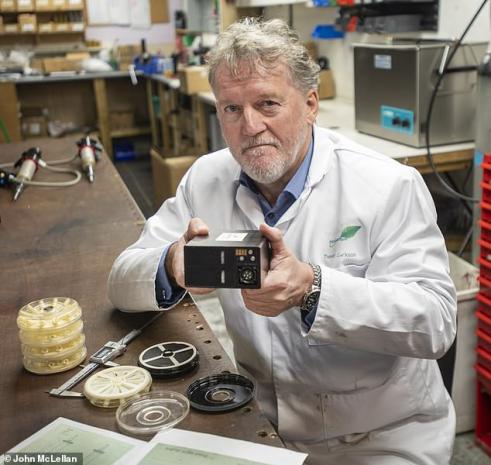
Breaking News
 This roof paint blocks 97% of sunlight and pulls water from the air
This roof paint blocks 97% of sunlight and pulls water from the air
 'Venomous' Republican split over Israel hits new low as fiery feud reaches White House
'Venomous' Republican split over Israel hits new low as fiery feud reaches White House
 Disease-ridden monkey that escaped from research facility shot dead by vigilante mom protecting...
Disease-ridden monkey that escaped from research facility shot dead by vigilante mom protecting...
 Hooters returns - founders say survival hinges on uniform change after buying chain...
Hooters returns - founders say survival hinges on uniform change after buying chain...
Top Tech News
 The 6 Best LLM Tools To Run Models Locally
The 6 Best LLM Tools To Run Models Locally
 Testing My First Sodium-Ion Solar Battery
Testing My First Sodium-Ion Solar Battery
 A man once paralyzed from the waist down now stands on his own, not with machines or wires,...
A man once paralyzed from the waist down now stands on his own, not with machines or wires,...
 Review: Thumb-sized thermal camera turns your phone into a smart tool
Review: Thumb-sized thermal camera turns your phone into a smart tool
 Army To Bring Nuclear Microreactors To Its Bases By 2028
Army To Bring Nuclear Microreactors To Its Bases By 2028
 Nissan Says It's On Track For Solid-State Batteries That Double EV Range By 2028
Nissan Says It's On Track For Solid-State Batteries That Double EV Range By 2028
 Carbon based computers that run on iron
Carbon based computers that run on iron
 Russia flies strategic cruise missile propelled by a nuclear engine
Russia flies strategic cruise missile propelled by a nuclear engine
 100% Free AC & Heat from SOLAR! Airspool Mini Split AC from Santan Solar | Unboxing & Install
100% Free AC & Heat from SOLAR! Airspool Mini Split AC from Santan Solar | Unboxing & Install
 Engineers Discovered the Spectacular Secret to Making 17x Stronger Cement
Engineers Discovered the Spectacular Secret to Making 17x Stronger Cement
UK Man Invents Aluminum Air Battery In His Garage

Now imagine that power source uses recycled aluminum, one of the most abundant metals on Earth, and an electrolyte so non-toxic you can drink it.
Image credit: Chemicum/YouTube
Call this power source a battery. Call it a fuel cell. Call it whatever you like. It is an invention that could upend energy storage as we know it and drive the electrification of transportation — from bicycles and neighborhood electric vehicles to heavy trucks, airplanes, and cargo ships — forward at warp speed.
The person behind all this is UK engineer and former Royal Navy officer Trevor Jackson, who began experimenting with aluminum air batteries at his workshop in the Cornish town of Callington in 2001. At that time, the electrolyte used was extremely caustic and poisonous. After years of experimentation, Jackson devised a new electrolyte — whose composition is a closely guarded secret — he says make it possible for his invention to power an electric car for up to 1,500 miles.
What happens when it runs out of juice? You replace it with a new one while the old one gets recycled. At the beginning of the electric car era when charging infrastructure was nonexistent, the idea of swapping spent batteries for fully charged new ones was considered feasible. Jackson says such a thing could be the future, with his batteries/fuel cells sold at grocery stores and retail outlets. He says the process of disconnecting the old one and connecting the new one will take about 90 seconds.
But is it tin foil hat time? Is this story just another example of some crackpot inventing some radical new product that defies conventional physics, like cold fusion? Lots of people think so, and in fact Jackson says powerful forces have attempted to prevent his idea from reaching a larger audience. But an independent evaluation by the UK Trade and Investment agency in 2017 said Jackson's invention was a "very attractive battery" based on "well established'" technology, and that it produced much more energy per kilogram than standard electric vehicle types, according to a report in the Daily Mail.
Some comparisons are in order. A Tesla Model S can drive up to 370 miles on a single charge. Jackson says if you drove the same car with an aluminum-air cell that weighed the same as the Tesla's lithium-ion battery, it would have a range of 2,700 miles. Aluminum-air cells also take up less space. If that same Tesla were fitted with an aluminum-air fuel cell the same size as its current battery, it could run non-stop for 1,500 miles.
Jackson says the battery for that long range Tesla Model S costs about £30,000. Tesla aficionados will probably quibble with that number but Jackson claims his aluminum-air battery/fuel cell that could power the same car for longer would cost just £5,000. Of course, it the owner has to spend £5,000 every 1500 miles, the economic case for the new energy source is compromised somewhat. Time will tell.
Multi-Million Dollar Deal Is Signed
Think this is all crazy talk? Consider this. Jackson has just signed a multi-million dollar deal with Austin Electric, an engineering firm based in Essex which now owns the rights to use the old Austin Motor Company logo. It will begin putting thousands of them into electric vehicles next year. According to Austin's chief executive, Danny Corcoran, the new technology is a "game-changer. It can help trigger the next industrial revolution. The advantages over traditional electric vehicle batteries are enormous."




